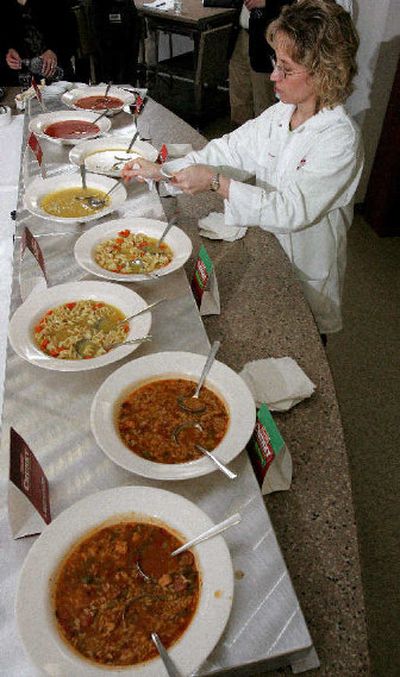A salty tale

CAMDEN, N.J. — Executives at the Campbell Soup Co. have heard the same thing almost since Andy Warhol was making art out of their cans in the 1960s: Lower the sodium in soup without sacrificing taste and people will eat even more of it.
Now, after years of gradually reducing the sodium in its soups, the company says it has made a breakthrough: natural, low-sodium sea salt. It will be used in about 30 soups — both new and reformulated recipes — scheduled to be on supermarket shelves in August, Campbell announced Wednesday.
“We’ve been everywhere on the globe trying to find a sea salt with all the characteristics of this one,” Chief Executive Douglas R. Conant told The Associated Press in an interview.
The company is hoping the lower-sodium salt will help soup sales, which have stabilized recently after losing ground to other convenience foods in the 90’s.
Regular table salt is 99.7 percent sodium chloride. The federal Food and Drug Administration says that adults should eat no more than 2,300 milligrams a day — or just under a teaspoon.
A few years ago, the average serving of a Campbell’s soup contained almost half the daily limit. By using less salt, the company got its average down to 850 milligrams.
The sea salt in the new soups has 40 percent less sodium than the regular stuff, said George Dowdie, Campbell’s vice president for research and development.
The salt change will give the company room to tout other health benefits of its soups, like it did back in the 1980s with its “Soup is good food” ads. The company agreed to halt that campaign after the government complained in 1989 that it was misleading because of the high sodium levels.
Under FDA rules, foods must meet several criteria — such as containing certain nutrients and having low cholesterol levels — before its label and advertisements can bill it as “healthy.” Many of Campbell’s soups meet all the requirements except for one: They have more than 480 milligrams of sodium per serving.
Some of the soups — including four to six varieties of the hearty Chunky soups — will get below that threshold thanks to the sea salt. The company then will market them as healthy and advertise how they are low-calorie, low-fat, vegetable-rich foods.
“We look at it as the enabler to talk about the other health benefits of soup,” said Denise Morrison, president of Campbell USA. The company is ramping up promotions, such as its Soup for Life Plan, a wellness and weight-loss campaign that revolves around soup.
The sea salt also is being used in Campbell’s 12 child-oriented soups, such as Chicken Alphabet and Kids Shapes, and versions of the soups the company calls its icons — chicken noodle, tomato and cream of mushroom.
The sodium reduction is the latest phase of efforts to revive a once-mighty company that fell into hard times in the late 1990s. When Conant took over in 2001, he promised to revive the condensed soup business, which had been slipping for years as more convenient quick-meal options emerged.
Campbell’s reported Feb. 17 that sales rose two percent in the first half of fiscal year 2006 over the year-ago period, to $4.4 billion, and soup sales rose at the same rate, to $2 billion. Net earnings rose to $556 million for the first half ended Jan. 29, up 20 percent from a year ago, or 11 percent, once adjusted for accounting changes.
The company has made strides in quality, using a new process to mix its soups that allows for bigger chunks of vegetables and a fresher taste, and introducing a higher-priced line of gourmet soups. It has also worked on convenience, adding microwavable soup bowls, drinkable soups, putting pop-top lids on cans and coming up with a new system to organize the soups in supermarkets.